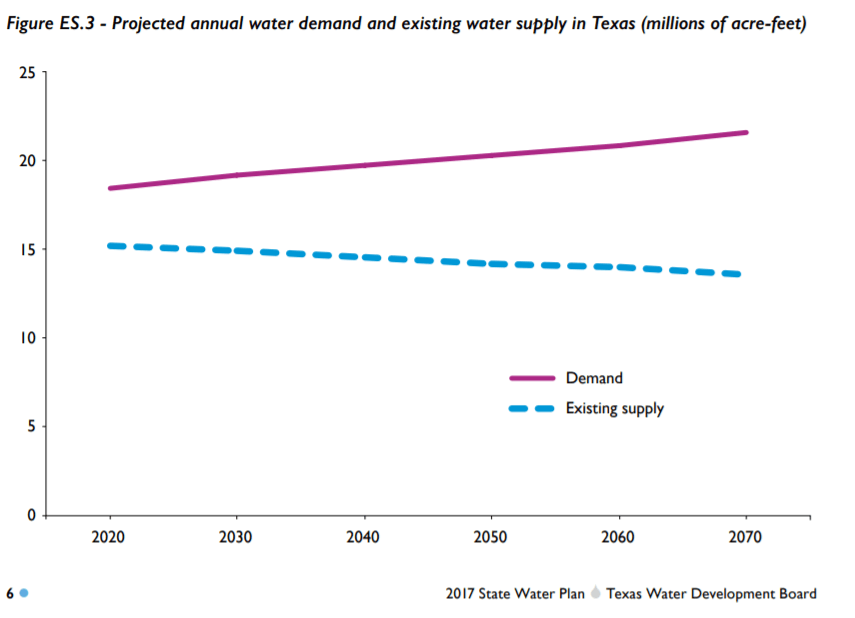Now, what does the future availability of Texas’s water resources look like? The state government has predictions for this as part of a regular water planning process run through the Texas Water Development Board. Data referenced here is from the 2017 State Water Plan. Simply looking at demand and supply, demand is estimated to rise 17% between 2020 and 2070, to a total of 21.6 million acre-feet. Water supply is predicted to fall by 11%, from 15.4 million acre-feet to about 13.6 million acre-feet in 2070. This means that by 2070, there could be an approximately 9 million acre-feet deficit in water availability. If nothing is done to help alleviate this, 82% of people living in the state could face at least a 10% water shortage and about ⅓ of Texans would have less than half of the water resources they need by 2070. This potential water crisis is caused by a variety of factors. These include a rapidly growing population (Texas’s population is expected to expand 70% between the years 2020 and 2070) and an overuse of finite water resources, among many other more minor reasons.
So, what is the state planning to do? The Water Plan lays out a variety of strategy recommendations that could be employed to help close the gap between water supply and water demand. These fall under several categories, including demand management, drought management, water reuse, and the enhancement of existing water supplies (mainly surface water). The biggest strategy the state plans to use (45% of the recommended strategies) is the augmentation of surface water resources, which includes the creation of reservoirs, building new pipelines to transfer previously developed resources to new places, and expanding the capacity and efficiency of infrastructure. Demand management/water conservation related strategies account for 30% of the plan’s suggestions. The rest of the suggested strategies include water reuse, groundwater-related strategies, and strategies relating to the use of seawater. However, even with full use of these strategies, the water development board still predicts that during a drought Texas would still have a shortage of 400,000 acre-feet of water under drought of record conditions. Beyond this, climate change will likely make droughts more severe. A study from UT Arlington found that soil moisture in North Texas will likely decrease by 10-15% in all seasons by the year 2050. That added with the general trend of government inaction on environmental issues makes the problem even worse. Although Texas has been progressive in adopting its current water plan, there is no guarantee all goals laid out in the plan will be met.
This should motivate concerned citizens to both conserve more water in their personal lives as well as lobbying the government to adopt more forward-looking water policies. Check out this past blog by TCEQ for tips on how you can do your part and conserve water around the house!
Blog Post Written by Kate Cox, Program Intern.





